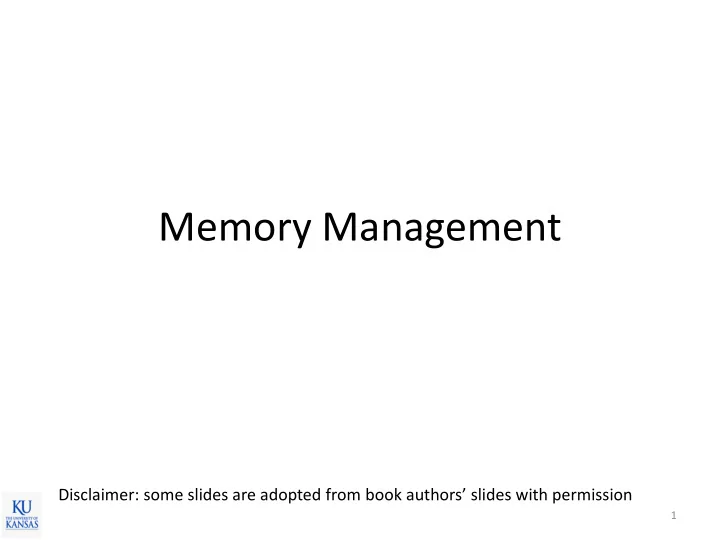

Memory Management Disclaimer: some slides are adopted from book authors’ slides with permission 1
Roadmap • CPU management – Process, thread, synchronization, scheduling • Memory management – Virtual memory • Disk management • Other topics 2
Administrative • Project 2 is out – Due: 11/06 3
Memory Management • Goals – Easy to use abstraction • Same virtual memory space for all processes – Isolation among processes • Don’t corrupt each other – Efficient use of capacity limited physical memory • Don’t waste memory 4
Concepts to Learn • Virtual address translation • Paging and TLB • Page table management • Swap 5
Virtual Memory (VM) • Abstraction – 4GB linear address space for each process • Reality – 1GB of actual physical memory shared with 20 other processes • How? 6
Virtual Memory • Hardware support – MMU (memory management unit) – TLB (translation lookaside buffer) • OS support – Manage MMU (sometimes TLB) – Determine address mapping • Alternatives – No VM: many real- time OS (RTOS) don’t have VM 7
Virtual Address Process A Process C Process B MMU 8 Physical Memory
MMU • Hardware unit that translates virtual address to physical address Virtual Physical address address CPU MMU Memory 9
A Simple MMU • BaseAddr: base register • Paddr = Vaddr + BaseAddr P3 • Advantages 28000 – Fast P2 • Disadvantages 14000 – No protection – Wasteful P1 10
A Better MMU • Base + Limit approach – If Vaddr > limit, then trap to report error – Else Paddr = Vaddr + BaseAddr 11
A Better MMU • Base + Limit approach – If Vaddr > limit, then trap to report error – Else Paddr = Vaddr + BaseAddr P3 • Advantages – Support protection P2 – Support variable size partitions • Disadvantages P1 – Fragmentation 12
Fragmentation • External fragmentation – total available memory space exists to satisfy a request, but it is not contiguous P4 Free Alloc P2, P4 P5 P3 P3 P3 P5 P2 P1 P1 P1 13
Modern MMU • Paging approach – Divide physical memory into fixed-sized blocks called frames (e.g., 4KB each) – Divide logical memory into blocks of the same size called pages (page size = frame size) – Pages are mapped onto frames via a table page table 14
Modern MMU • Paging hardware 15
Modern MMU • Memory view 16
Virtual Address Translation Virtual address 0x12345678 Page # Offset Ox12345 0x678 0x678 0x12345 Physical address 0xabcde678 offset frame #: 0xabcde frame # 17
Advantages of Paging • No external fragmentation – Efficient use of memory – Internal fragmentation (waste within a page) still exists 18
Issues of Paging • Translation speed – Each load/store instruction requires a translation – Table is stored in memory – Memory is slow to access • ~100 CPU cycles to access DRAM 19
Translation Lookaside Buffer (TLB) • Cache frequent address translations – So that CPU don’t need to access the page table all the time – Much faster 20
Issues of Paging • Page size – Small: minimize space waste, requires a large table – Big: can waste lots of space, the table size is small – Typical size: 4KB – How many pages are needed for 4GB (32bit)? • 4GB/4KB = 1M pages – What is the required page table size? • assume 1 page table entry (PTE) is 4bytes • 1M * 4bytes = 4MB – Btw, this is for each process. What if you have 100 processes? Or what if you have a 64bit address? 21
Paging • Advantages – No external fragmentation • Two main Issues – Translation speed can be slow • TLB – Table size is big 22
Multi-level Paging • Two-level paging 23
Two Level Address Translation Virtual address 1 st level 2 nd level offset Base ptr 2 nd level Page 1 st level Physical address Page table Frame # Offset 24
Multi-level Paging • Can save table space • How, why? 25
Summary • MMU – Virtual address physical address – Various designs are possible, but • Paged MMU – Memory is divided into fixed-sized pages – Use page table to store the translation table – No external fragmentation: i.e., efficient space utilization 26
Recommend
More recommend